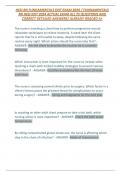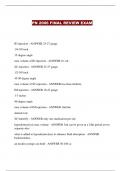Other
Mock NCLEX study guide
- Course
- Nur 4315
- Institution
- William Paterson University
This document has all the topics that will be on the mock NCLEX for nur4315 (professional license prep) class. Orthopedic Disorders: Bryant’s Traction, Fractured Hip. Cancer: Breast Cancer, CLL, Lung cancer. Thyroid disorders: Thyroidectomy, Hypothyroid. Dehydration manifestations in the eld...
[Show more]












